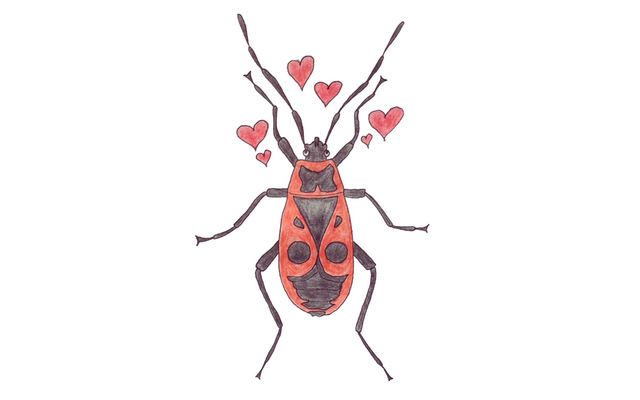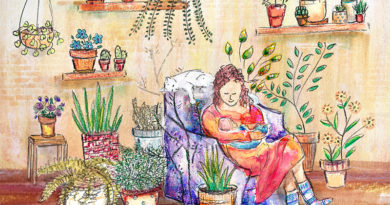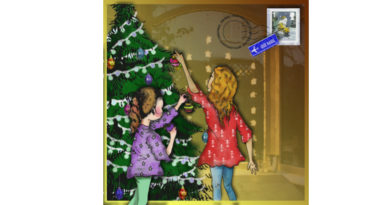Swiss Firebugs, Beagles and Ikea Crocodiles

There’s a German children’s song called “Auf der Mauer, auf der Lauer sitzt ‘ne kleine Wanze.” (Literal translation: On the wall, waiting in ambush, sits a small bug.) My children loved the song because it is a gap song where the last letter is left out with each repetition, and once you get to simply humming, well, then you start all over again. Great for car rides. It certainly beats quibbling out of boredom. Satisfied that they were entertained for an indefinite period, I never really took the time to look up what a Wanze was. I figured that they had learned it at kindergarten, so – nothing to worry about.
Now that they are older, the song has lost its charm (dare I say: thank goodness?) and their interests have changed. My youngest came home excitedly from school the other day, saying, ‘‘I know the best place to find them.”
“What exactly are you talking about?” I asked. “Feuerwanzen, of course.” “Wanzen!” There was that word again. Now I had the time and I googled it: “Firebugs!”
“What exactly do you want to do with firebugs?” was my next question. “Bring them home of course. Does it say what they eat, Mummy?” In fact, there was a lot of useful information, but the most surprising to me was the fact that they mate somewhere between 12 hours and seven days. My daughter seemed to already have caught on: “Look – they stick to each other all the time because they are making babies.”
Now what did my six-year-old daughter know about how babies are made, and was this the right time to address the issue? Then I remembered the Sex-Koffer (Koffer=suitcase) that had been introduced in the local Swiss kindergarten. We had all been shown pictures of the soft-toy anatomical parts and the rather explicit cartoons that were included in the suitcase and could be used to demonstrate how and where and what. The idea is to start at an early age, in the hope of making the children more aware of sex and thus also possibly help prevent child molestation. Fair point, of course – but in kindergarten?
It is still a very disputed suitcase. Especially as it is entirely up to the kindergarten teacher when and how and even whether they choose to use the suitcase at all. As this concerned only my youngest girl – the others had already been through kindergarten, innocently, so to speak – I wasn’t too sure I liked the idea. Had she been introduced to the suitcase already without my knowing?
I didn’t have time to find out, as my daughter was busy wanting a bowl to catch the firebugs in. We had to fill it with all sorts of grasses and a little water, which seemed to make them more willing to mate as they clambered on top of each other to get out. However, it wasn’t the suitcase I needed to worry about….
Later in the evening I heard giggling from the living room. It was a conspiratorial sort of giggle, the sort that tears at your subconscious with the immediate need to drop everything and check on it. “Look. What’s Sherlock doing to the Ikea crocodile?” asked my youngest, pointing at our darling beagle, who was making a very obvious action toward the soft toy I use as a draught-stopper.
“Making babies,” the older ones chuckled. “You shouldn’t be laughing at him. Take the crocodile away. Stop that, Sherlock,” I said, and separated them.
“Do you know how babies are made?” I heard her older sister say to her. And before I could react, I found myself listening to my ten-year-old daughter dive into an exact physiological description of the mechanics, that indeed nearly had me blushing…whilst she didn’t bat an eyelid. And there was no sign of childish smirking from anyone.
“Now when did you learn all that?” I asked, thinking to myself that if my ten-year-old is in a “pre-suitcase” class where sex was not on the agenda, what will my youngest be learning when they tackle the topic? Her beloved primary teacher had taught them, she explained. The teacher had obviously decided to take matters into her own hands, with all the suitcase discussions going on.
Neither of the other children had any questions. None were needed. My son, nearly twelve, who is still in the old Orientierungschule school system, didn’t appear to have this in-depth sort of knowledge about the topic and I had noticed he’d been listening intently. Pretending not to, but he’d sucked in every word.
I realised I was grateful for my older daughter’s naturalness, her boldness and her matter-of-factness. Not that I would have minded explaining things, but I couldn’t have brought it off the way she had. I realised that kids have their own ways of finding out and communicating the adult world to each other, and finally I understood the euphemism “the birds and the bees.” It’s all about observing nature in a natural way.
Each of my children was thus introduced to the topic at a different age, and in such a way that complemented their natural inquisitiveness, and for this I am grateful. Of course, this is not always the case. But I am not so sure anymore whether we can define what is too early. Even though the world we live in is so open and explicit, with advertisements and television and so on, I have found that there was some sort of natural selection going on – my kids asked when they were ready to hear. Thinking back, I realize that is exactly how I came to find out when I was my youngest daughter’s age. It mattered neither that it was a different era nor that it was a different continent altogether. With all these new theories and discussions and suitcases, I find this comforting.
They still shout, ‘‘YUCK!’’ when my husband and I give each other a kiss, though. So even though they may understand the theory, there is a long way to go before they get the rest. It’s sort of like that “Wanze” song – you deconstruct it to the core then build it up again as though nothing has changed and sing it all over again until you move on.
By Karin Mohler
Karin Mohler has lived in between cultures for her entire life and has come to the conclusion that this will always be a big part of her. Having no roots doesn’t bind her anywhere in particular, but she is careful not to impose that sense upon her children, who have been born and bred in Switzerland. She has taken a lot of inspiration for understanding her “in-betweenness” from the book Third Culture Kids: Growing Up Among Worlds, by D. C. Pollock and R. v. Reken (2009).
Illustration by Lara Friedrich
Currently a senior at the Kantonsschule Ausserschwyz in Nuolen, Lara is a freelance illustrator for Mothering Matters Magazine and a demo singer for the songwriter Kate Northrop. She has also written an article for the newspaper Marchanzeiger and is bilingual in English and German with a Cambridge First Certificate in English.



